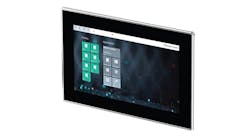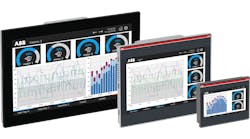Traveling lighter means traveling faster, farther—and hopefully getting more done. That's seems to be the slimmed down, New Year's resolution for many operator interface and human-machine interface (HMI) technologies and their users, who appear to have moved beyond simply displaying many data streams on all kinds of tablet PCs and smart phones, and are now prioritizing their devices and displays to give them the essential information they need for better decisions.
"Everyone is thirsting for information, but they also don't want to be overwhelmed, so many HMIs are getting streamlined in what they show, following the ISA101 HMI standard, and adopting less distracting, more contemporary grayscale displays," says Dan Malyszko, operations director and lead engineer at Malisko Engineering, a CSIA-certified system integrator in St. Louis, Mo. “The intent is to quickly draw attention where it's needed, so color is used sparingly, and animations are discouraged since they can distract from critical notifications. However, many operators are accustomed to colorful, P&ID-style graphics with animated representations such as active flow paths and level indications. Even though ISA101 may suggest that energized equipment be shown shaded white versus deenergized shaded gray, an operator with intimate process knowledge relies on seeing a clear flow path on the screen. In these situations, we have to adapt and suggest muted color pallets to try to satisfy the HMI standard while appeasing operations. It's a fine line, but we just try to find a middle ground to accomplish the goals of modern, high-performance HMI graphics.
"Of course, the flip side of the thirst for information is that users also want to view multiple data streams on fewer interfaces. There's a lot of talk about employing a 'single pane of glass,' but the reality is users need to see input from many disparate software packages. This can be resolved by delivering content relative to who the user is, where the user is, and what they're doing. For example, ACP ThinManager helps us deliver, manage, and maintain the security of content on their screens and tablet PCs. The challenge as HMIs evolve is to keep delivering relevant information to the right people at the right time."
Upgrades enable HMIs
Naturally, one of the optimal times to simplify HMIs, prioritize data streams, and consolidate displays is during larger process and production upgrades. For instance, Evonik Corp.'s plant in Mobile, Ala., is upgrading automation on several units. This animal nutrition products process includes sequential column start-up, crystallization, filtering and daily flush-out procedures.
Evonik is also upgrading the column from its phased-out APACS+ control system to newer PCS 7 controls from Siemens. This section of the Mobile facility has about 5,000 I/O overall, while the immediately affected process has 300-400 I/O. So far, basic engineering sequencing is done, and detailed engineering was scheduled to begin shortly. PCS 7 hardware and sequencing was implemented last fall, and the start-up is scheduled for April. Despite organizing the upgrade into two phases, there can be a three- to five-year "gray phase" between when the APACS+ OS HMI conversion is complete and when the I/O conversion phase is implemented.
"This migration is happening in two phases dictated by our shutdown schedule," says Patrick Spomer, senior project engineer for process control at Evonik. "The first is converting the HMI for the APACS+ operating system, implementing new Siemens industrial PCs, migrating to the PCS 7 architecture, and adding the AS410-5H controller and network infrastructure. The second phase is converting the APACS+ I/O to PCS 7 I/O, and taking into account safety instrumented system (SIS) considerations."
Spomer reports that some of the advantages of Evonik's upgrade plan include:
• Infrastructure is in place with industrial Ethernet modules (IEM) for communication between the legacy APACS+ and PCS 7 AS410H controllers, using a common PCS 7 OS HMI;
• Migration path forward is promoted during the gray phase;
• HMI functions implemented via sequential function chart (SFC) visualization faceplates are now auto-generated from the PCS 7 configuration;
• Removes up to two times the cost of implementing ladder logic diagrams (LLD) via detailed engineering labor reduction; and
• SFC type can be applied to multiple unit operations requiring same sequence.
Spomer adds that implementing SFC functions on Evonik's HMI will save an estimated 500 man-hours due to: savings on a per sequence basis because multiple sequences will now be identical; no sequence recreation from APACS+ to PCS 7 once ACM controllers are removed; and LLD being phased out by SFC/CFC to allow for programming and HMI advantages.
"The value gained during the gray phase of migration includes linking phases together with configuration, promoting our new philosophy in the plant, and putting new I/O in as PCS 7 I/O," explains Spomer. "During phase 2's piecewise I/O hardware conversion, we'll easily stage-swap I/O, and there will be minimal programming necessary outside of channel driver software."
In addition, Spomer reports that SFC HMI's advanced process library (APL) faceplates provide an advantage for operators to run successful sequences, while SFC code enables APACS+ I/O to PCS 7 I/O transitions without major, future reconfiguration. "We're also saving on engineering configuration costs by using SFC type bulk engineering capability," he adds. “SFC HMI faceplates give operators graphical and numerical information about where they are in a process without needing to view the engineering logic, which can help reduce cycle times and improve safety. Once implemented, SFC types will be used for HMI graphic process visualization in a future training system with Siemens SIMIT simulation software that we'll put in next year to train future operators.”
Combine to conquer
End users and system integrators report that HMI simplification typically means bringing together several interface and support technologies that used to be separate and required individual programming, configuration and maintenance. For example, Kinetrex Energy LNG in Indianapolis, Ind., upgraded its controls in 2014, but found it was constrained by its many existing, siloed software packages. Two years later, Kinetrex contracted with Miller-Eads, an electrical and automation contractor, also in Indianapolis, to implement Ignition software from Inductive Automation to help integrate its software and systems. The liquefied natural gas process at Kinetrex includes about 2,700 tags, 600 historical tags, approximately 50 screens, about 30 alarms, 12 clients including eight workstations, two tablets and a mobile display, standard Ignition architecture, single site MySQL database, and a Microsoft SQL database.
"We worked with Miller-Eads to identify, develop, test and deploy solutions for HMI, CMMS, data historian, trucking, logistical order taking and processing, as well as personnel time tracking and administrative reporting," says Charlie Hendrixson, automation services director at Miller-Eads. "We also developed solutions that allow Kinetrex to easily export transaction data to QuickBooks, and export customer-specific transactions to FuelQuest. A tablet-launched project was deployed to allow Kinetrex employees to complete industry-required hourly equipment and process inspections via tablet.
"We helped Kinetrex consolidate its existing software, both SaaS and standard on-premises, to gain efficiency and functionality. The unique aspect of this project is that Ignition integrates every single part of Kinetrex's business process from the operator to the accounting department."
Travis Cox, co-director of sales engineering at Inductive, adds, "There's not a lot of new HMI technologies, but there are new ways of approaching them. For instance, many people think of HMI and SCADA as one thing, but they can be separated. SCADA is usually the centrally located software and screen, while HMIs must guarantee local visibility and take care of edge functions. However, users still want to manage their HMIs centrally, but also make them part of a larger ecosystem, and make changes at their central desk that they can push to hundreds of HMI and other edge devices. Our two-year-old Ignition Edge and Ignition Edge Panel provide local HMI, and can be installed on any hardware the users wants, including a low-cost Raspberry Pi board. However, they're also managed centrally, and can talk MQTT to send data back to corporate locations, the cloud and other decision-making places."
Jeff Hayes, regional product manager at Beijer Electronics, reports, "Similar to smart phones that are merging functions like global positioning systems (GPS) and adding apps as needed, HMIs and PLCs with onboard computing, memory and data storage are running operating systems and software, and if they have multi-core processors, then they can run all kinds of apps. With added software, we can add PLC and I/O functions to HMIs, and add more hardware and software to design HMIs for more specific applications on ships, packaging machines or oil rigs, and give operators whatever objects they need to see that will make a difference."
Hayes adds, even though capacitive touchscreens with sweep and multi-touch zoom functions continue to replace traditional resistive touchscreens, there's also been a move towards "screen-less HMIs" that include a circuit board and CPU memory, power, enclosure and networking, but dispense with the usual display and touchscreen, leaving that function to a third-party handheld with HMTL 5 and wireless networking. "Opto 22's groov is a good example of a screen-less HMI that's simple and costs less because about half the cost of an HMI is the screen," he says.
In fact, Opto 22 announced a new version of groov in October that embeds IIoT technologies MQTT and OPC-UA drivers directly into its industrial edge appliance. Added to its groov View software for web and mobile visualization and open-source Node-RED development environment, Opto 22 says its new release offers engineers, technicians, and developers a comprehensive set of tools for edge deployment in industrial environments. These new embedded capabilities are made possible through forging close partnerships with Inductive and Cirrus Link Solutions, and are part of the Ignition Edge Onboard program.
Beyond skipping screens, Hayes says that some HMIs are also adding calculation and control capabilities. For example, Beijer just released its X2 series of HMIs with PLC functions, including X2 Extreme Sealed, which is an HMI that doesn't require an enclosure because it can be mounted almost anywhere. "Instead of a panel with a DIN rail behind it, X2 has the HMI and PLC all in one unit, which usually costs half as much as running them separately," he adds.
Acclimating to interface
Even with the best-designed, most-innovative HMIs, developers report it can still take time to get operators used to them. Luckily, there are many helpful tools to get them up to speed.
"For decades, SCADA has been the eyes and hands of the PLC for the operator, but modern SCADA hasn't evolved as other software has done," says Mario Ishikawa, co-founder and business director at scadaHUB, a CSIA-member system integrator in Florianópolis, Brazil, which often uses SCADA software from Elipse to build and renovate HMI screens (Figure 1) for local power companies and do outsourced SCADA projects for other system integrators including some in the U.S.
[sidebar id =1]"Twenty years ago, many operators only accessed a computer when they interacted with their SCADA system at work, but now they use laptops, tablet PCs and smart phones all the time, so their expectations of the user experience is much greater," adds Ishikawa. "Still, many in-plant screens aren't good and have old 3D graphics that are too bright, so we've been programming screens and graphics according to principles in Hollifield and Habibi's High Performance HMI Handbook that stress the actual needs of plants and users, follow technical standards, and make HMIs comfortable to use."
Cox reports that Inductive also advises its users to follow the handbook's techniques, such as presenting operators with moving, analog indicators on their HMIs. These vertical bars typically show actual operating levels, but this data is displayed within accepted operating ranges, which are more effective for maintaining operator awareness. [An Inductive white paper on HMIs is located here.
Ishikawa adds that new interfaces and SCADA displays can be hard for users to understand, but training can help them progress from complaining on the first day to acceptance and approval after the first week. "We recently worked on renewing an application with panel displays with a lot of cells that weren't comfortable, were visually polluted, and hard to read from just a few feet away," explains Ishikawa. "The new system has a much more comfortable interface, but because operators had learned the right positions on the old displays, their first reaction was not favorable. However, after one week, they got used to the new displays that were less complex."
To help operators adapt to new HMIs, Malyszko reports that some vendors have added built-in software objects with common equipment status indicators to provide a common look and feel throughout a system. "When operators are doing material transfers, for example, there may be many manual hookups using proximity switches for validation of flow paths. Software objects in newer HMIs allow us to consolidate this verification information into configurable faceplates to show if their hookups are OK or not. For instance, Rockwell Automation’s Library of Process Objects, a part of the PlantPAx DCS, has built-in permissive and interlock objects that can be easily configured to show what's holding up a process. This means developers no longer have to write custom code and one-off graphics, but can instead use pre-developed, standard objects that are already tested and valid. We're not eliminating application-specific code in the PLCs and PACs, but rather simplifying the deployment for a more consistent and focused user experience.”
Safe at the edge
Another benefit of simpler HMIs and prioritized data is deploying these capabilities further out in the field. For example, Lynchburg Regional Waste Treatment Plant in Lynchburg, Va., recently implemented controls with an integrated development environment (IDE) from Bedrock Automation to upgrade and control their dechlorination and stormwater remediation applications. The utility treats an average of 13 million gallons per day from the city and surrounding communities. System integrator Instrulogic Corp. in Round Hill, Va., provided programming to help deploy and integrate these functions within the city's existing Ignition SCADA/HMI system from Inductive Automation.
“We wanted to transform from a centralized to a distributed approach using edge controller capabilities. Bedrock enables us to use remote monitoring, bringing many devices online into our SCADA system for the first time," explains Jason Hamlin, SCADA manager, City of Lynchburg. "Providing public access to the existing scanner/alarm in the current environment meant opening access to the SCADA system, which we could not do. Bedrock’s cybersecurity allows us to confidently monitor overflows and feed data to the Ignition SCADA system, while providing public notifications."
Chris Harlow, product and customer service manager at Bedrock, adds that, "A lot of infrastructure that's more than 10 years old can't be torn out, so we need to better protect PLCs that are in place. Bedrock's OSA platform helps secure legacy PLCs by occupying slots between existing controls and existing SCADA systems, and acting as a hardware-based firewall that runs it's own control code. As a result, it doesn't just pass encrypted data, but also serves as a secure proxy that monitors and translates data from less-secure PLC protocols like Modbus, Profinet and EtherNet/IP to more-secure OPC UA using our public-private infrastructure, and triggers alerts and alarms based on anomalies that let users react in real time. This is more effective than regular firewalls."






